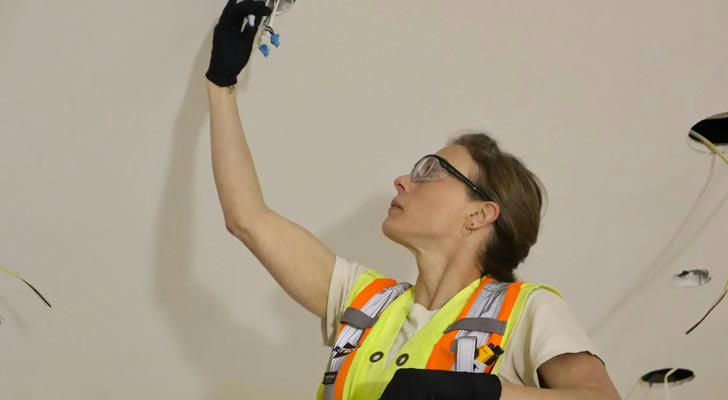Is Electrical Work Suitable for Women? A Look at the Success Stories of Three Female Career Changers
Traditionally, the electrical trade has been viewed as a male-dominated field. However, with the gradual breaking down of gender barriers in various professions, more and more women are beginning to make their mark in this industry. They are not only challenging societal stereotypes but also injecting fresh energy into the field. This article examines the real-life experiences of three women who made career changes to become electricians, analyzing the feasibility, advantages, and challenges of women pursuing electrical work, offering valuable insights for women interested in entering the field.

Industry Overview
According to the 2023 Professional Skills Development Report, the percentage of women in the electrical trade has risen from 3.8% five years ago to 6.5%. Although the overall percentage remains low, the trend is clearly upward. Women have seen significant growth in niche sectors such as residential circuit installation and smart home configurations.
Furthermore, numerous vocational training institutions have launched specialized courses tailored for women in the electrical field, covering basic circuit knowledge, electrical installation and maintenance, smart system configurations, and energy-saving technologies. These courses have lowered entry barriers and encouraged more career changers to try their hand at becoming electricians.
Case 1: From Administrative Assistant to Senior Electrician
Zhang Min (pseudonym), 32, formerly an administrative assistant at a corporation. She had worked in her previous job for seven years, but despite her efforts, she had never received a promotion, and her salary growth was slow. One day, she accompanied a friend to sign up for an electrical basics training course and was immediately captivated by the content. She soon resigned from her job to devote herself full-time to learning, obtaining both her electrical operation certificate and senior electrician qualification.
During her studies, Zhang Min demonstrated a high level of initiative. She scheduled four hours of theoretical learning every day and practiced hands-on exercises under the guidance of her trainers during the evenings. To overcome her fear of high-altitude work, she voluntarily joined a construction project for on-site training, gradually building confidence.
Currently, she works for a large property management company, maintaining and conducting daily inspections of electrical systems in commercial complexes. She is skilled at quickly locating faults and handling high-voltage equipment safely, often being requested specifically by clients for her services.
Advantages:
Attention to Detail: She exhibits greater concentration and logical reasoning abilities when troubleshooting circuits.
Communication Skills: She is able to gain the trust of clients when discussing equipment issues, particularly in emergency situations where empathy is key.
Learning Ability: Her theoretical exam pass rate exceeds that of male students, and she has often ranked highly in practical assessments.
Career Development:
Base Salary: Increased by approximately 60% compared to her previous job, with quarterly performance bonuses and project subsidies.
Certifications: She is currently preparing for the Registered Electrical Engineer exam and plans to move into project design and review in the future.
Career Reflection: “Electric work is not just about carrying cables and tightening screws; it’s a profession based on logic and skills. Women can excel in this field too.”
Case 2: Female Electrician Team Leader in Smart Manufacturing
Li Fang (pseudonym), 28, a graduate in mechatronics. Upon graduating, she was uncertain about her career path. After trying various roles such as receptionist and copywriter, she ultimately decided to join a smart car manufacturing company, starting with basic electrical equipment maintenance.
When she first entered the workshop, she felt overwhelmed by the complex automated control systems and the dense network of sensor circuits. However, she did not retreat but instead kept a daily work log and studied PLC programming and electrical schematics in her spare time. Three months into her job, she successfully identified a wiring error that had caused a production line shutdown, earning high praise from her supervisor.
Within three years, she had earned both a mid-level electrician certificate and a PLC application certification. She also became the team leader of the electrical group, managing a team of eight, including three male colleagues. She led an automation upgrade project in the workshop, which increased production efficiency by more than 15%.
Job Features:
Automation Equipment Maintenance: 70% of her daily work involves tasks such as frequency converter debugging and servo controller setup, which require precision operations.
High Skill Requirements: She needs to master PLCs, industrial communication protocols, mechanical principles, and other interdisciplinary knowledge.
Low Physical Strain: Most of the work involves monitoring, debugging, and troubleshooting, with minimal physical labor.
Team Management Experience: She emphasizes collaboration within her team, frequently organizing group discussions to improve technical knowledge sharing. She is especially supportive of newly hired female electricians and has promoted the company’s "Female Technician Support Program."
Industry Insight: “The electrical roles in smart manufacturing focus more on technical comprehension rather than physical strength, offering new opportunities for women in the industry.” — Equipment Supervisor at an automotive company
Case 3: Entrepreneurial Electric Circuit Testing Expert
Wang Li (pseudonym), 35, a former physics teacher. Having taught subjects such as electricity and optics for many years, Wang Li had a strong theoretical foundation in electrical knowledge. After relocating her family, she left her teaching job and, on the suggestion of a friend, decided to transition into professional electrical circuit testing.
Using her teaching experience, she self-studied electrical courses and developed a “non-destructive circuit testing” service, which utilized thermal imaging and non-contact voltage detection to diagnose circuit problems without damaging wall structures. This service quickly became popular among owners of high-end homes and shops.
In the early days of her business, she combined online course teaching with offline practical training to improve her skills. She not only earned a senior electrician certificate but also received "Electrical Safety Inspector" certification. She established her brand and used social media to promote case studies, gaining a significant following and a steady stream of clients.
Business Features:
“Non-destructive” Testing Service: This approach significantly reduces renovation and repair costs for clients while improving satisfaction.
Standardized Service Process: Includes pre-assessment, in-process explanations, and post-test reports, creating a complete service loop.
High Customer Satisfaction: Maintains a 98% positive review rate across multiple platforms, with repeat customers accounting for over 40%.
Entrepreneurial Challenges and Achievements: In the beginning, many clients doubted her expertise as a “female electrician.” However, through the use of professional tools and detailed explanations, she gradually built trust. Today, she has expanded her team to include three assistant technicians and generates over 600,000 RMB in annual revenue.
Market Feedback: “Female electricians often gain more trust from family clients, especially when dealing with electrical systems in children’s rooms and other sensitive areas.” — Project Manager at a renovation company

Advantages of Female Electricians
Strong Fine Motor Skills: Women tend to be more detail-oriented and perform exceptionally well when using precision instruments such as oscilloscopes and detection devices.
High Safety Awareness: Data shows that female electricians experience fewer work-related injuries than the industry average.
Service Differentiation: Women are often more successful at building trust with clients, particularly in home-based services, which boosts customer loyalty.
Strong Learning and Adaptation Skills: Female trainees tend to have higher theoretical exam pass rates and attendance compared to their male counterparts.
Challenges to Overcome
Physical Demands in Certain Scenarios: Tasks such as outdoor cable laying and high-altitude installations still require team collaboration or assistance from specialized tools.
Industry Bias Still Exists: Some traditional businesses and clients hold biases against female electricians, which can affect employment opportunities.
Occupational Safety Issues: Women need to pay extra attention to health risks such as electromagnetic radiation and exposure to chemicals, and should use protective gear designed for their body types.
Recommendations for Entering the Field
1. Skill Preparation:
Prioritize obtaining nationally recognized professional qualifications (such as an electrical operation certificate or senior electrician certificate).
Learn cutting-edge skills in PLC, smart homes, and energy-efficient circuits to enhance your competitiveness.
2. Career Choices:
It’s advisable to start in roles such as property management, factory work, or after-sales service to gain experience and build a portfolio of projects.
Long-term career paths may include electrical circuit design, project management, or entrepreneurship.
3. Protective Measures:
Choose tools, insulated shoes, and protective clothing designed specifically for women.
Regularly undergo occupational health checks, with a focus on musculoskeletal health and the effects of the electrical environment.

Expert Opinions
A director of the electrical engineering department at a vocational college points out: “The electrical industry is transitioning from a labor-intensive field to a technology-intensive one. Gender differences in this regard are diminishing. The key going forward is to establish a fair and scientific skills evaluation system, allowing all practitioners, regardless of gender, to advance based on their abilities.”
Conclusion
Career choices should not be constrained by gender. The electrical industry offers vast opportunities for women as well. The experiences of these three career changers demonstrate that with systematic learning, continuous practice, and skill accumulation, women can thrive in the electrical industry and achieve career success.
For women aspiring to join this field, it is crucial to assess their strengths, choose the right learning paths, and develop a clear career direction. With the progress of societal recognition and industry transformation, it is expected that more women will find their own space in this traditionally male-dominated field in the future.
